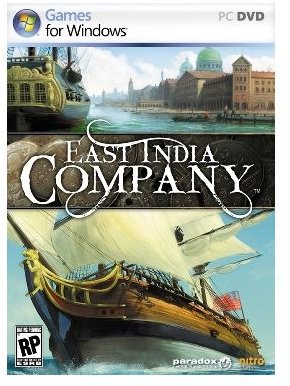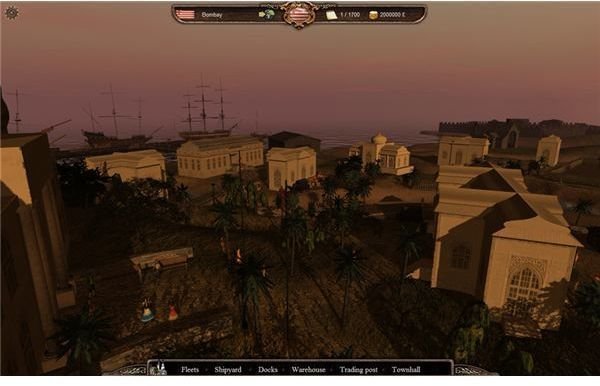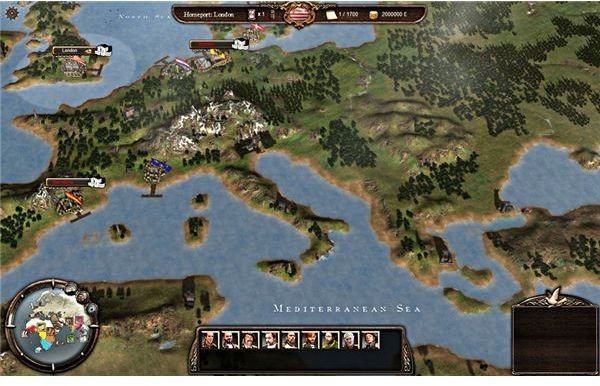East India Company Guide: Maximising Profits

East India Company Tutorial and Tips
East India Company is an in depth trading simulation with real-time naval combat. It’s a single player game with a choice of campaigns. The grand campaign ties everything together and challenges the player to guide their chosen East India Company to success starting in 1600. In this article we are going to provide some general tips to help you with the campaign. Here is our East India Company review.
There are some tutorials and you can elect to play the game with tips and tutorial missions turned on. This is recommended for your first outing as it guides you through the basic process of building fleets and trading goods. The menu system is a little convoluted so it may take you a few turns to discover and understand all the options open to you.
Cash Flow
Trade is the principle aim of East India Company. As a company you have to make profit to stay in business. In fact if you run out of cash and don’t climb back into the black within a year your company will be closed down. Cash flow is vital, without a healthy bank balance it is game over. This leads us to our second point. In order to trade effectively you need liquid cash to buy goods. Do not make the mistake of spending every penny on new Galleons, because you need working capital in order to buy more goods.
Maximising Profits

You want to maximise your profit so never sail with an empty hold. When you enter a foreign port, click on your fleet and select cargo hold. Open the Trading Post tab on the other half of the screen and drag goods across to buy them. You can hold CTRL and left click to grab units of ten tons or kilos at once. It may be slightly awkward but you can also buy maximum by holding CTRL and clicking the left and right mouse buttons together to drag goods across to your hold. Each ship type has a different capacity. Military ships that can hold marines use their cargo capacity to hold them so if you have a full contingent of marines you can’t carry goods.
The prices of each product, whether spices, tea or porcelain, are clearly displayed. The majority give a price per ton but there are exceptions such as diamonds which are measured in carats. You can see the profit per ton you will make by selling the item in your home port. Obviously the higher profit items are the ones you want to go for. When buying goods at your home port for the outbound voyage you’ll need to manually check the prices in foreign ports. Some will offer a great profit on guns or tools while others won’t bring much of a return at all. While it is worth trying to maximise the outbound profit don’t focus on it because the real money is to be made by importing exotic goods.
Importing Goods

The campaign goals will challenge you to import large quantities of specific goods. It is best to deal with these first and complete them well within the time limit so you have no pressure later on. Remember though, the more of a single good that you sell in a specific port the lower the price will drop. There is a clear system of supply and demand and flooding the market has the effect you would expect. Prices will recover gradually over time so space out your sales. This works the other way too. The more there is of a commodity at a foreign port the cheaper it will be to buy.
You can set up automatic trade routes and tell fleets to buy and sell goods autonomously but they don’t always make great choices and they can also sometimes spend all of your money at an inopportune moment. If you are rich and ahead of schedule with your goals then the auto-routes are handy, otherwise I’d maintain control of every voyage.
Capturing Ports
In order to improve your position you will also be asked to capture foreign ports. In order to capture a foreign port you sail a fleet in and select an auto-resolve battle. I would recommend you only attack ports with fleets of five using Galleons, Frigates or Ships of the Line. You should also make sure you have a full contingent of marines on each ship. You can recruit marines at ports with a Garrison Level 2 or above. You can actually win the game by conquering all 12 of the Indian ports and holding them for 10 years but this is easier said than done. You can also capture other ports, not just Indian ones, and I highly recommend you do.
Re-Supply Fleets
Your fleets will need to stop for re-supply quite frequently during voyages and if they have no friendly ports to enter you will run into problems. The ports of your competitors are not open to you unless you engage in diplomacy which can be costly. A tactic which has worked well for me is to capture a line of ports down the West coast of Africa. Every fleet has to stop for re-supply and if you own all the ports then the companies are forced to deal with you and secure pacts for access. This can bring lucrative deals to the bargaining table.
Developing Ports and Building

There is also some building involved in East India Company. The ports that you own can be developed. It is highly advisable to develop the Trading Post in particular because you will then be able to buy goods at a discounted price. You also need to build forts and garrisons for defence. If you want to be able to build and repair your fleets you’ll need to build a shipyard too. Some building developments cost money, the majority cost a combination of money and tools. On outward voyages it is a good idea to take as many tools as you can buy and store them in the warehouses of your foreign ports. Even if you don’t upgrade buildings immediately this means when you do come to do it the option will be there.
Building Fleets
When it comes to building fleets you want to have multiple fleets on the go at once. There is a trade off between flexibility and security. The smaller the fleet the faster it can go and the more options you have, but the greater the risk from pirates and enemies. I’d recommend having a dedicated attack fleet for dealing with major pirates and taking ports. For trade you should have at least two fair sized fleets with some protection and one fast fleet for quick missions. As a security blanket it can be worthwhile keeping a reserve of goods in your home warehouse which you can sell to build a new fleet in case you have a disastrous loss at sea.
Small Missions
As the campaign progresses you will be offered various small missions via the message system located in the bottom right hand corner of the HUD. Always try and do them because the extra cash is invaluable. Keep a fast fleet for deliveries and micro-manage their voyage to avoid pirates. The only missions you should occasionally ditch are the ones which involve attacking foreign powers. If you aren’t in a strong position you don’t want to engage in a war.
Diplomacy

The diplomacy system is fairly basic. If you are strong then the AI opponents will not represent any threat. If you are weak they will eat you alive. You can sometimes make good deals with them and they might be persuaded to swap Indian ports for African ones, but on the whole it is best to let them come to you. If you focus on building strength they will inevitably try to strike deals with you and the terms will be favourable.
This East India Company guide focuses on campaign advice. There is also a dedicated guide for naval combat in East India Company. Happy sailing, keep those profits rolling and watch out for pirates.
